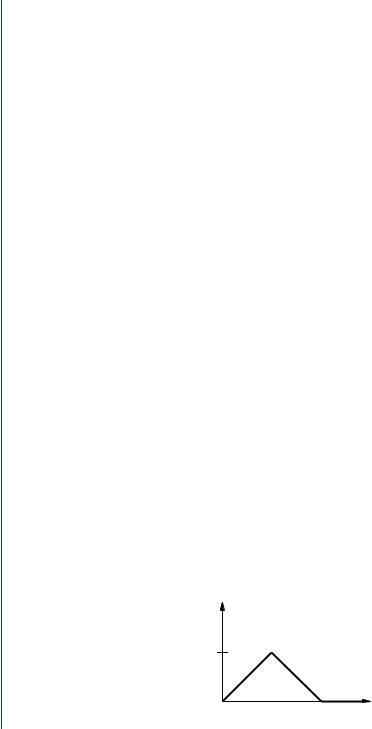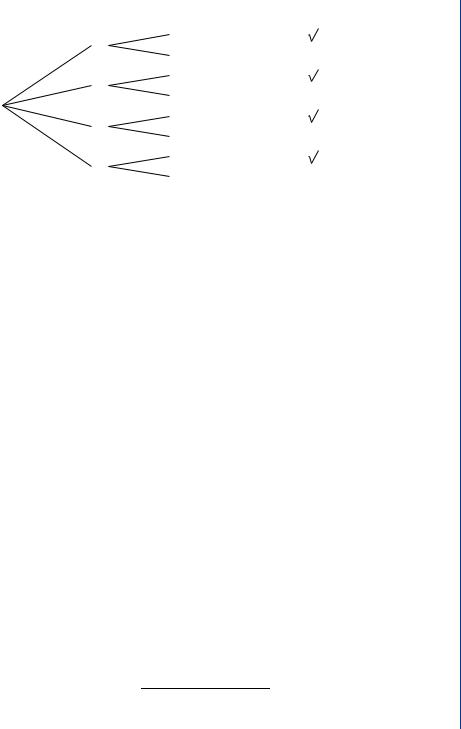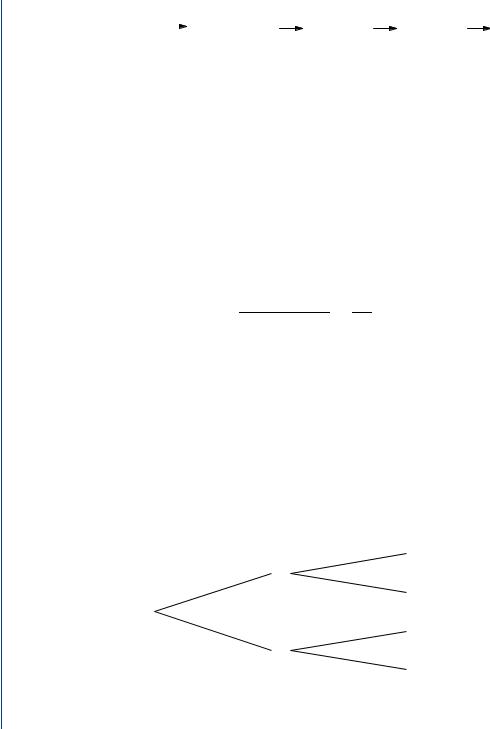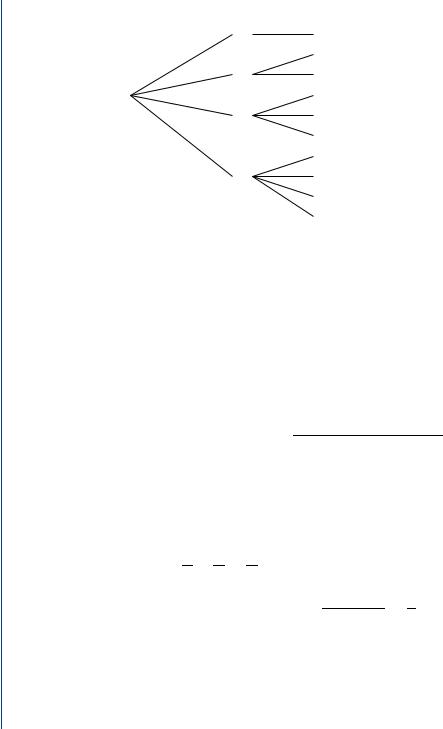
Basic Probability Theory for Biomedical Engineers - JohnD. Enderle
.pdf
INTRODUCTION 51
The proof that FA is indeed a σ-field of subsets of SA is left to the reader (see Problem 1.45). The probability measure PA is defined on the measurable space (SA, FA) by
PA(BA) = |
P (B ∩ A) |
|
= P (B| A) |
. |
(1.73) |
|
P (A) |
||||||
|
||||||
If P (A) = 0 we may define PA to be any valid probability measure; in this case, PA(BA) = P (B) is often a convenient choice.
Now consider the conditional independence of events A and B, given an event C occurred. Above, we interpreted a conditional probability as an unconditional probability defined with a sample space equal to the given event. Thus, the conditional independence of A and B is established in the new sample space C by testing
PC (AC ∩ BC ) = PC (AC )PC (BC )
or in the original sample space by testing
P (A ∩ B|C) = P (A|C)P (B|C).
Note that independent events are not necessarily conditionally independent (given an arbitrary event).
Example 1.8.1. A number is drawn at random from S = {1, 2, . . . , 8}. Define the events A = {1, 2, 3, 4}, B = {3, 4, 5, 6}, and C = {3, 4, 5, 6, 7, 8}. (a) Are A and B independent?
(b) Are A and B independent, given C?
Solution. (a) We find P (A) = P (B) = 1/2 and P (A ∩ B) = 1/4 = P (A)P (B), so that A and B are independent. (b) We find P (A|C) = 1/3, P (B|C) = 2/3, and P (A ∩ B|C) = 1/3, so that A and B are not independent, given C.
Random Sampling of Waveform
One is often interested in studying the frequency of occurrence of certain events even when the observed phenomena is inherently deterministic (not random). Here, we consider the “random” sampling of a deterministic waveform. Sample the time function f (t) uniformly at t = kT, for k = 0, 1, . . . , N − 1, where T > 0 is called the sampling period. The outcome space for the experiment is the set of all pairs of k and f (kT ): S = {(k, f (kT )) : k = 0, 1, . . . , N − 1}. We assume that each outcome in the outcome space is equally likely to occur.
Example 1.8.2. The waveform shown in Fig. 1.11 is uniformly sampled every one-half second from (T = 0.5). Define the events A = { f (kT ) > 5/4}, B = {0.5 ≤ f (kT) < 2}, and C = {2 ≤ t < 3}. Find (a) P (A|B), (b)P (C), (c )P (B|C).

52 BASIC PROBABILITY THEORY FOR BIOMEDICAL ENGINEERS
Solution. There are nine equally likely outcomes. In the following list, a check in the appropriate row indicates whether the sample point ζ is an element of event A, B, or C.
SAMPLE POINT, ζ |
A |
B |
C |
|
|
|
|
|
|
(0,0) |
|
√ |
|
|
(1,0.5) |
|
|
||
(2,1) |
√ |
√ |
|
|
(3,1.5) |
√ |
√ |
||
(4,2) |
√ |
√ |
||
(5,1.5) |
√ |
√ |
||
(6,1) |
|
√ |
|
|
(7,0.5) |
|
√ |
|
|
(8,0) |
|
|
|
|
|
|
|
|
(a)With the aid of the above list, we find P (A) = 3/9, P (B) = 6/9, and P (A ∩ B) = 2/9. Hence
P (A | B) = |
|
P (A ∩ B) |
|
|
2/9 |
|
|
|
1 |
. |
|
|||
|
|
|
= 6/9 |
|
|
|
|
|||||||
|
P (B) |
|
= 3 |
|
||||||||||
(b) We find P (C) = 2/9. |
|
|
|
|
|
|
|
|
|
|
|
|
|
|
(c) We have P (B ∩ C) = 1/9, so that |
P (B ∩ C) |
|
|
1/9 |
|
|
1 |
|
|
|
||||
|
|
|
|
|
. |
|
|
|||||||
|
|
|
|
|
|
|
|
|
|
|||||
P (B|C) = |
|
= |
2/9 = |
2 |
|
|||||||||
|
P (C) |
|
|
|||||||||||
Probability Tree
A probability tree is a natural extension of both the concept of conditional probability and the tree diagram. The tree diagram is drawn with the tacit understanding that the event on the right side of any branch occurs, given that the sequence event on the pathway from the origin to the left side of the branch occurred. On each branch, we write the conditional probability of the
f(t)
2
0 |
|
|
|
|
t |
|
2 |
4 |
|||||
|
|
|||||
FIGURE 1.11: Waveform for Example 1.8.2

INTRODUCTION 53
event at the node on the right side of the branch, given the sequence event on the pathway from the origin to the node on the left side of the branch. The probabilities for the branches leaving the origin node are, of course, written as unconditioned probabilities (note thatP (A|S) = P (A)). The probability of each event equals the product of all the branch probabilities connected from the origin to its terminal node. A tree diagram with a probability assigned to each branch is a probability tree. The following theorem and its corollary justify the technique.
Theorem 1.8.1. For arbitrary events A1, A2, . . . , An we have |
|
P (A1 ∩ A2 ∩ · · · ∩ An) |
(1.74) |
= P (A1)P (A2| A1)P (A3| A1 ∩ A2) · · · P (An| A1 ∩ A2 ∩ · · · ∩ An−1). |
|
Proof. For any k {2, 3, . . . , n}, we have |
|
P (A1 ∩ A2 · · · ∩ Ak ) = P (Ak | A1 ∩ A2 · · · ∩ Ak−1)P (A1 ∩ A2 · · · ∩ Ak−1); |
|
applying this for k = n, n − 1, . . . , 2 establishes the desired result. |
|
The above theorem provides a useful expansion for the probability of the intersection of n events in terms of conditional probabilities. An intersection of n events is not an ordered event; however, the treatment of joint probabilities in the previous section enables us to apply the above theorem to an (ordered) sequence event and establish the following corollary.
Corollary 1.8.1. The probability for the sequence event A1 A2 · · · An may be expressed as
P (A1 A2 · · · An) = P (A1)P (A2| A1)P (A3| A1 A2) · · · P (An| A1 A2 · · · An−1). |
(1.75) |
Example 1.8.3. Two cards are drawn at random from an ordinary deck of 52 cards without replacement. Find the probability p that both are spades.
Solution. Let us set up a probability tree with event Si denoting a spade drawn on the ith draw, as shown in Fig. 1.12. The probability of any event in the probability tree is equal to the product of all of the conditional probabilities of the branches connected on the pathway from the origin to the left of the event. Therefore
p = P (S1 S2) = P (S1)P (S2|S1) = |
13 12 |
= |
1 |
. |
||
|
|
|
|
|||
52 51 |
17 |
|||||
Partitioning a sample space often simplifies a problem solution. The Theorem of Total Probability provides analytical insight into this important process.

54 BASIC PROBABILITY THEORY FOR BIOMEDICAL ENGINEERS
|
|
|
|
Event |
P(.) |
|||||
|
P(S2 |S1 ) |
S1S2 |
|
13 12 |
||||||
|
|
|
|
|
||||||
|
|
52 51 |
||||||||
|
S1 |
|
|
|
|
|
|
|
|
|
P(S1 ) |
|
|
|
|
|
|
39 13 |
|||
|
P(Sc |
|S ) |
S Sc |
|||||||
|
|
|
|
|
||||||
|
|
51 52 |
||||||||
|
2 |
1 |
|
1 |
2 |
|||||
|
P(S |
|Sc |
) |
Sc S |
|
|
13 39 |
|||
|
2 |
51 52 |
||||||||
P(Sc |
2 |
1 |
|
1 |
|
|||||
) |
|
|
|
|
|
|
|
|
|
|
1 |
Sc |
|
|
|
|
|
|
|
|
|
|
|
|
|
|
|
|
|
|
|
|
|
1 |
|
|
|
|
|
|
|
|
|
|
P(Sc |
|Sc |
) |
Sc Sc |
|
38 39 |
||||
|
|
|
|
|
||||||
|
|
52 51 |
||||||||
|
2 |
1 |
|
1 |
|
2 |
||||
FIGURE 1.12: Probability tree for Example 1.8.3
Theorem 1.8.2 (Total Probability). |
Let A1, A2, . . . , An be a partition either of S or of B. Then |
|||
P (B) = |
n |
|
|
|
P (B| Ai )P (Ai ). |
(1.76) |
|||
|
|
i=1 |
|
|
Proof. We have |
|
|
|
|
B = B ∩ (A1 A2 · · · An) |
|
|||
so that |
|
|
|
|
n |
P (B ∩ Ai ) = |
n |
|
|
P (B) = |
P (B| Ai )P (Ai ). |
|||
i=1 |
|
|
i=1 |
|
Partitioning a sample space is usually logical and can result in a solution of what appears at first to be an extremely difficult problem. In fact, the Theorem of Total Probability allows us to easily solve problems that have previously been solved by using a probability tree, as in the next example.
Example 1.8.4. We have four boxes with a composition of defective light bulbs as follows: Box Bi contains 5%, 40%, 10%, and 25% defective light bulbs for i = 1, 2, 3, and 4, respectively. Pick a box and then pick a light bulb from that box at random. What is the probability that the light bulb is defective?
Solution. We solve this problem first using a probability tree and then by applying the Theorem of Total Probability. Since each box is equally likely, we have P (Bi ) = 1/4 for i = 1, 2, 3, 4. Let D be the event that a defective light bulb is selected. From the probability tree shown in

|
|
|
|
|
INTRODUCTION 55 |
|
|
|
|
P(.) |
Defective |
|
|
.05 |
D |
0.0125 |
|
|
|
B1 |
Dc |
0.2375 |
|
.25 |
|
.95 |
|
||
.25 |
.4 |
D |
0.1 |
|
|
|
B1 |
Dc |
0.15 |
|
|
|
|
.6 |
|
||
|
|
.1 |
D |
0.025 |
|
.25 |
.25 |
B3 |
Dc |
0.225 |
|
.9 |
|
||||
|
|
.25 |
D |
0.0625 |
|
|
|
B4 |
Dc |
0.1875 |
|
|
|
.75 |
|
FIGURE 1.13: Probability tree for Example 1.8.4
Fig. 1.13 we have
4
P (D) = P (Bi ∩ D) = 0.0125 + 0.1 + 0.025 + 0.0625 = 0.2.
i=1
From the Theorem of Total Probability,
|
4 |
1 |
|
|
|
|
|
P (D) = |
P (Bi )P (D|Bi ) = |
(0.05 |
+ 0.4 + 0.1 + 0.25) |
= 0.2. |
|||
|
|||||||
4 |
|||||||
|
i=1 |
|
|
|
|
|
A Posteriori Probabilities
The probabilities that have been computed in all of our previous examples are known as a priori probabilities. That is, we are computing the probability of some event that may or may not occur in the future. Time is introduced artificially, but it allows us to logically follow a sequence. Now, suppose that some event has occurred and that our observation of the event has been imperfect. Given our imperfect observation, can we deduce a conditional probability for this event having occurred? The answer is yes, such a probability is known as an a posteriori probability and Bayes’ Theorem provides a method of computing it.
Theorem 1.8.3 (Baye’s Theorem). Let A1, A2, . . . , An be a partition of the outcome space S, and let B F be an arbitrary event. Then
P (Ai )P (B| Ai )
P (Ai |B) = n . (1.77) j =1 P (A j )P (B| A j )

56 BASIC PROBABILITY THEORY FOR BIOMEDICAL ENGINEERS |
|
||||||||||||
|
|
|
|
|
|
|
|
|
|
|
|
||
|
Scource |
|
Transmitter |
|
|
Channel |
|
Receiver |
|
|
|||
|
|
|
|
|
|
|
|||||||
|
|
|
|
|
|
|
|
|
|
|
|
|
|
FIGURE 1.14: Typical communication system |
|
|
|
|
|
|
|
||||||
Proof. From the definition of conditional probability, |
|
|
|
|
|||||||||
|
|
P (Ai |B) = |
P (Ai ∩ B) |
|
= |
P (Ai )P (B| Ai ) |
. |
|
|||||
|
|
P (B) |
|
|
|||||||||
|
|
P (B) |
|
|
|
|
|||||||
Using the Theorem of Total Probability to express P (B) yields the desired result. |
|
||||||||||||
Example 1.8.5. In Example 1.8.4, suppose the light bulb was defective. What is the probability it came from Box 2?
Solution. From Bayes’ Theorem
P (B2|D) = P (B2)P (D|B2) = 0.1 = 0.5.
P (D) 0.2
Example 1.8.6. The basic components of a binary digital communication system are shown in Fig. 1.14. Every T seconds, the source puts out a binary digit (a one or a zero), which is transmitted over a channel to the receiver. The channel is typically a telephone line, a fiber optic cable, or a radio link, subject to noise which causes errors in the received digital sequence, a one is interpreted as a zero and vice versa. Let us include the uncertainty introduced due to noise in the channel for any period with the probability tree description shown in Fig. 1.15, where Si is the binary digit i sent by the source, and Ri is the binary digit i captured by the receiver.
Determine (a) the probability of event C, the signals are received with no error, and (b) which binary digit has the greater probability of being sent, given the signal was received correctly.
P(R0|S0) = 0.8 |
R0 |
S0 |
|
P(S0) = 0.7 |
|
P(R1|S0) = 0.2 |
R1 |
P(R0|S1) = 0.1 |
R0 |
P(S1) = 0.3 |
|
S1 |
|
P(R1|S1) = 0.9 |
R1 |
FIGURE 1.15: Probability tree for Example 1.8.6

|
|
|
|
|
|
|
|
|
|
|
|
|
|
|
|
|
|
|
|
INTRODUCTION |
57 |
||||
Solution |
|
|
|
|
|
|
|
|
|
|
|
|
|
|
|
|
|
|
|
|
|
|
|
|
|
(a) From the Theorem of Total Probability |
|
|
|
|
|
|
|
|
|
|
|
|
|
|
|
|
|
|
|
|
|||||
P (C) = P (S0)P (R0|S0) + P (S1)P (R1|S1) = |
7 |
|
8 |
|
|
3 |
9 |
= 0.83. |
|
||||||||||||||||
|
|
|
|
|
+ |
|
|
|
|
|
|
|
|||||||||||||
10 10 |
|
10 |
10 |
|
|||||||||||||||||||||
(b) From Bayes’ Theorem, we determine |
|
|
|
|
|
|
|
|
|
|
|
|
|
|
|
|
|
|
|
|
|||||
P (S0|C) = |
P (S0)P (C|S0) |
= |
(7/10)(8/10) |
= |
56 |
|
|
||||||||||||||||||
|
|
|
|
83/100 |
|
|
|
|
|
|
|||||||||||||||
P (C) |
|
|
|
|
|
83 |
|
|
|||||||||||||||||
and |
|
|
|
|
|
|
|
|
|
|
|
|
|
|
|
|
|
|
|
|
|
|
|
|
|
P (S1|C) = |
|
P (S1)P (C|S1) |
= |
(3/10)(9/10) |
= |
27 |
|
|
|
|
|
|
|
||||||||||||
|
|
|
|
|
|
|
|
|
|
|
|
|
|
|
|||||||||||
|
|
P (C) |
|
83/100 |
|
83 |
|
|
|
|
|
|
|
||||||||||||
which implies that a zero has the greater probability of being sent correctly. |
|
||||||||||||||||||||||||
Drill Problem 1.8.1. The waveform f (t) is uniformly sampled every 0.1s from 0 to 4 s, where |
|
||||||||||||||||||||||||
f |
( |
) |
= |
2t |
if 0 ≤ t ≤ 2 |
|
|
|
|
|
|
|
|
|
|
|
|
||||||||
t |
|
|
4e −2(t−2) |
if 2 < t |
≤ |
4. |
|
|
|
|
|
|
|
|
|
|
|
|
|
||||||
|
|
|
|
|
|
|
|
|
|
|
|
|
|
|
|
|
|
|
|
|
|
|
|
|
|
Evaluate the probability that: (a) |
|
f (t) ≤ 1; (b) f (t) ≥ 2, given |
|
f (t) ≤ 3; (c) a value is from the |
|||||||||||||||||||||
f (t) = 2t portion of the curve, given f (t) ≤ 1. |
|
|
|
|
|
|
|
|
|
|
|
|
|
|
|
|
|
|
|
|
|||||
Answers: 8/35, 20/41, 6/20.
Drill Problem 1.8.2. Two balls are drawn without replacement from an urn that contains four green, six blue, and two white balls. Evaluate the probability that: (a) both balls are white; (b) one ball is white and one ball is green; (c) the first ball is blue, given that the second ball is green.
Answers: 24/44, 16/132, 2/132.
Drill Problem 1.8.3. The waveform f (t) is uniformly sampled every 0.1 s from −1 to 2 s, where
−t |
if − 1 ≤ t ≤ 0 |
f (t) = t |
if 0 < t ≤ 1 |
sin 21 π t |
if 1 < t ≤ 2. |
Evaluate the probability that: (a) f (t) ≤ 0.5, given −1 ≤ t ≤ 0; (b) f (t) ≤ 0.5, given 0 < t ≤ 1; (c ) f (t) ≤ 0.5, given 1 < t ≤ 2; (d ) f (t) ≤ 0.5; (e ) − 1 ≤ t ≤ 0, given f (t) ≤ 0.5.
Answers: 6/15, 1/2, 6/11, 4/10, 15/31.

58 BASIC PROBABILITY THEORY FOR BIOMEDICAL ENGINEERS
Drill Problem 1.8.4. Four boxes contain the following quantity of marbles.
|
RED |
BLUE |
GREEN |
|
|||
|
|
|
|
Box 1 |
6 |
3 |
2 |
Box 2 |
5 |
4 |
0 |
Box 3 |
3 |
3 |
4 |
Box 4 |
2 |
9 |
7 |
|
|
|
|
A box is selected at random and the marble selected is green. Determine the probability that: (a) box 1 was selected, (b) box 2 was selected, (c) box 3 was selected, (d) box 4 was selected.
Answers: 0, 385/961, 180/961, 396/961.
1.9SUMMARY
In this chapter, we have studied the fundamentals of probability theory upon which all of our future work is based. Our discussion began with the preliminary topics of set theory, the sample space for an experiment, and combinatorial mathematics. Using set theory notation, we developed a theory of probability which is summarized by the probability space (S, F, P ), where S is the experimental outcome space, F is a σ-field of subsets of S (F is the event space), and P is a probability measure which assigns a probability to each event in the event space. It is important to emphasize that the axioms of probability do not dictate the choice of probability measure P . Rather, they provide conditions that the probability measure must satisfy. For the countable outcome spaces that we have seen so far, the probabilities are assigned using either the classical or the relative frequency method.
Notation for joint probabilities has been defined. The concept of joint probability is useful for studying combined experiments. Joint probabilities may always be defined in terms of intersections of events.
We defined two events A and B to be independent iff (if and only if )
P (A ∩ B) = P (A)P (B).
The extension to multiple events was found to be straightforward.
Next, we introduced the definition for conditional probability as the probability of event B, given event A occurred
P (B| A) = P (A ∩ B) ,
P (A)

INTRODUCTION 59
|
|
|
Outcome |
k |
|
|
|
0.5 |
H |
HH |
2 |
|
k |
|
H |
|
|
|
0.25 |
0 |
0.5 |
0.5 |
T |
HT |
1 |
|
|
0.5 |
|
|||||
|
|
|
|
|
1 |
|
0.5 |
|
|
|
|
|
|
0.5 |
H |
TH |
1 |
0.25 |
|
|
|
|
|||||
|
T |
|
|
|
2 |
|
|
|
|
|
|
||
|
0.5 |
T |
TT |
0 |
|
|
|
|
(a) |
|
|
(b) |
|
FIGURE 1.16: Partial tree diagram for Example 1.9.1
provided that P (A) = 0. The extension of the definition of conditional probability to multiple events involved no new concepts, just application of the axioms of probability. We next presented the Theorem of Total Probability and Bayes’ Theorem.
Thus, this chapter presented the basic concepts of probability theory and illustrated techniques for solving problems involving a countable outcome space. The solution, as we have seen, typically involves the following steps:
1.List or otherwise describe events of interest in an event space F,
2.Assignment/computation of probabilities, and
3.Solve for the desired event probability.
The following example illustrates each of these steps in the solution.
Example 1.9.1. An experiment begins by rolling a fair tetrahedral die with faces labeled 0, 1, 2, and
3.The outcome of this roll determines the number of times a fair coin is to be flipped.
(a)Set up a probability tree for the event space associating the outcome of the die toss and the number of heads flipped.
(b)If there were two heads tossed, then what is the probability of a 2 resulting from the die toss?
Solution. Let n be the value of the die throw, and k be the total number of heads resulting from the coin flips.
(a)Since it is fairly difficult to draw the probability tree for this experiment directly, we shall develop it in stages. We first draw a partial probability tree shown in Fig. 1.16(a) for the case in which the die outcome is two and the coin is flipped twice. This probability tree can be compressed into a more efficient event space representation as shown in

60 BASIC PROBABILITY THEORY FOR BIOMEDICAL ENGINEERS
|
|
n |
1 |
|
k |
n,k |
P(.) |
|
|
0 |
|
0 |
0,0 |
1/4 |
|
|
|
|
|
||||
0.25 |
0.25 |
1 |
0.5 |
|
0 |
1,0 |
1/8 |
|
0.5 |
|
1 |
1,1 |
1/8 |
||
|
|
|
|||||
|
|
|
|
0 |
2,0 |
1/16 |
|
|
|
|
.025 |
|
|||
|
|
2 |
0.5 1 |
2,1 |
1/8 |
||
|
0.25 |
|
|||||
|
|
.025 |
|
2 |
2,2 |
1/16 |
|
0.25 |
|
|
|
||||
|
|
1/8 |
|
0 |
3,0 |
1/32 |
|
|
|
|
3/8 |
||||
|
|
3 |
|
1 |
3,1 |
3/32 |
|
|
|
|
|
3/8 |
2 |
3,2 |
3/32 |
|
|
|
1/8 |
|
|||
|
|
|
|
3 |
3,3 |
1/32 |
|
|
|
|
|
|
|||
FIGURE 1.17: Tree diagram for Example 1.9.1
Fig. 1.16(b). It should be clear that the probability of any face occurring on the die toss is equal to 1/4 and that the values that k takes on as well as the probabilities are dependent on n.
We can draw the probability tree for the entire event space by continuing in the same manner as before. The result is shown in Fig. 1.17.
(b) Using Bayes’ Theorem,
P (n = 2|k = 2) = P (n = 2)P (k = 2|n = 2) .
P (k = 2)
To find P (k = 2) we can use the tree diagram and sum the probabilities for all events that have k = 2 or use the Theorem of Total Probability to obtain
P (k = 2) = P (k = 2|n = 2)P (n = 2) + P (k = 2|n = 3)P (n = 3), so that P (k = 2) = 161 + 323 = 325 . Finally,
P (n = 2|k = 2) = (1/4)(1/4) = 2 . 5/32 5
Drill Problem 1.9.1. Professor S. Rensselaer teaches a course in probability theory. She is a kindhearted but very tricky old lady who likes to give many unannounced quizzes each week. She determines the number of quizzes each week by tossing a fair tetrahedral die with faces labeled 0, 1, 2, and 3. The more quizzes she gives, however, the less time she has to assign and grade homework problems. If Ms. Rensselaer is to give Q quizzes during the next week, then the conditional probability she will assign
